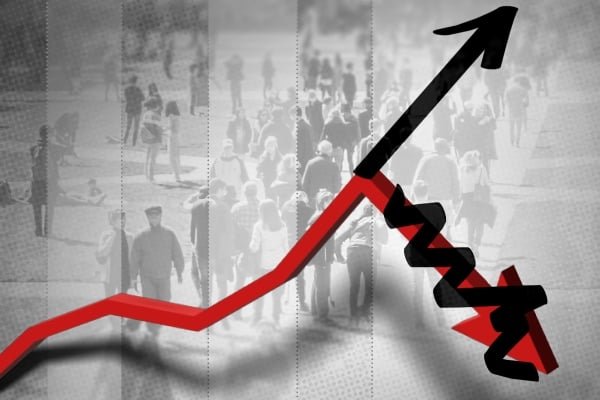Erroneous data showed first-year decline; it actually rose
In October, the National Student Clearinghouse Research Center released its annual preliminary “Stay Informed” enrollment report, which proclaimed that first-year college enrollments had fallen by 5 percent from fall 2023 to fall 2024. That would have signified the largest decline since the COVID-19 pandemic.
The data, it turns out, was false. On Monday, the NSC acknowledged that a methodological error led to a major misrepresentation of first-year enrollment trends. In fact, the nonprofit said, first-year enrollment appears to have increased last fall.
NSC officials said the error was caused by mislabeling many incoming first-year students as dually enrolled high school students—which also helps explain the whopping 7.2 percent increase in dual enrollment in the October report. The error also compromised a special report on 18-year-old enrollment and FAFSA completion that the NSC published in December with the National College Attainment Network.
Doug Shapiro, the research center’s executive director, wrote in an email to Inside Higher Ed that the research team uncovered the mistake while preparing its upcoming Current Term Enrollment Estimates report, set to release next Thursday. Results for that report—which uses different methodology—showed significantly higher first-year enrollments, Shapiro said, prompting a retroactive review of the October report.
Shapiro also said the error has been present for every prior “Stay Informed” report going back to the first in 2020. They caught it this year, he added, because the impact was magnified by a general uptick in dual enrollment. Researchers are still reviewing the report methodology, he said, and will provide more information on the cause of the error when it becomes available.
“The National Student Clearinghouse Research Center acknowledges the importance and significance of its role in providing accurate and reliable research to the higher education community,” Shapiro wrote. “We deeply regret this error and are conducting a thorough review to understand the root cause and implement measures to prevent such occurrences in the future.”
It’s no small mistake. The claim that freshman enrollment had fallen precipitously shaped discussions of the higher ed landscape for months. It appeared to validate claims that high school graduates were turning away from higher education and confirmed fears that last year’s bungled rollout of the new federal aid form would curtail college access. Inside Higher Ed reported on the finding across multiple articles, and it was featured prominently in major news outlets including The New York Times and The Washington Post.
There were a few early signs that the data may have been amiss. The Education Department flagged a potential issue with the NSC report in October, noting that its financial aid data showed a 5 percent increase in students receiving federal aid. In a statement Monday night, Under Secretary James Kvaal said the department was “encouraged and relieved” by the NSC’s correction.
But for the most part the mistake has come as a shock to higher ed leaders and researchers, and it threatens to undermine the NSC’s position as the premier source for enrollment data.
Bill DeBaun, NCAN’s senior director of data and strategic initiatives, worked directly with the NSC research team on their joint special report. His experience didn’t raise any flags at the time, he said, and he’s “surprised with a capital S” by the error, since FAFSA completion rates in September remained nearly nine percentage points behind the 2023–24 cycle.
“Within the bad news there’s also good news: that we’re actually building momentum from 2023,” DeBaun said. “That said, it is certainly surprising. The last financial aid cycle was extremely difficult for students and families, and this would be the first time that FAFSA completion data and first-year enrollment went in opposite directions.”
I still have faith in the research center, and I appreciate the transparency. It is not easy to admit to a mistake of this scale.”
—Bill DeBaun, NCAN
A Research Reckoning?
The NSCRC’s enrollment reports are among the most widely used in higher education: Policymakers, institutional leaders and media outlets rely on them for an early, comprehensive window into the academic year’s enrollment trends. As prognosticators fret over higher ed’s decline, the NSC reports are often treated as a thermometer for a feverish sector, the primary indicator of its health on a national scale.
The latest data error may erode trust in the center. Some say a healthy dose of skepticism may not be a bad thing.
Dominique Baker, associate professor of education and public policy at the University of Delaware, has been a critic of the “Stay Informed” report, and the research center’s enrollment data more broadly, for years. She said its issues go beyond methodological errors, and that its “quick hit” strategy, relatively small data set and reliance on projection make it an unreliable source.
“People make coding errors. This one was significant, with real consequences,” she said. “But I’ve always been leery about the early NSC data. Even with everything coded and plotted correctly, there should be a heavy amount of skepticism about it.”
The “Stay Informed” report is, crucially, preliminary: It’s based on data collected from about half of all higher education institutions to project larger trends. It was created in the summer of 2020 to “provide early and real-time enrollment information to meet the acute information needs of the higher education community at the height of the COVID pandemic,” as the NSC put it.
Baker said the report’s origin story is part of its problem: It was built to feed the increasingly voracious appetite for early enrollment data, making it vulnerable to inaccuracies and oversights.
“If you’re awaiting a proclamation of doom, as many lawmakers and researchers have been, you want any information you can get your hands on and you want it as soon as possible,” she said. “It’s led to this zealous push to get information out as soon as possible, even though there’s not a lot of confidence behind it.”
The NSC’s more comprehensive winter data set has often differed from its preliminary cousin, though the disparity has never been this big before. In fall 2023, the “Stay Informed” report found that first-year undergraduate enrollment had fallen by 3.6 percent; a few months later, the winter report showed a 0.8 percent increase.
DeBaun said that while he’s disappointed in the error, he thinks it would be a mistake to let it undermine the NSC’s credibility in the field.
“I still have faith in the research center, and I appreciate the transparency. It is not easy to admit to a mistake of this scale,” he said. “[NSC] data really are important for shaping our understanding of college access and attainment. I wish this hadn’t happened, but it won’t dissuade me from using their research in the future.”
Food for the Data-Starved
Part of the reason the October data drew such amplified media coverage—outlets like The New York Times don’t always cover fall enrollment trends so closely—was that 2024 offered a confluence of high-profile higher education stories that raised the specter of an enrollment decline.
The Education Department’s bungled rollout of the new FAFSA slashed completion rates for the federal aid form, which many observers predicted would translate to lower overall enrollment in the fall. Spring protests over the Israel-Hamas war dominated headlines and sparked conjectures that students would turn away from higher ed due to the chaos. And as in previous years, the value proposition of a college degree continued to diminish in the public eye.
But the NSCRC’s profile has been rising since worries about the demographic cliff began accelerating in the mid-2010s. It exploded after the COVID-19 pandemic torpedoed enrollments in the fall of 2020, leaving higher ed advocates looking anxiously for signs of recovery in the following years.
The NSC, DeBaun said, remains the only source for timely, national data on student head counts and outcomes. That may be part of the issue.
The Education Department collects self-reported data from institutions, and compiles it in the Integrated Postsecondary Education Data System. But accurate IPEDS data comes out more than a year after the relevant academic year begins; enrollment numbers for fall 2024, for instance, won’t be released until January 2026 at the earliest. And IPEDS has historically collected data only on full-time, first-time undergraduate students, leaving a large and growing swath of nontraditional students out of the picture, though that’s beginning to change as calls for more comprehensive federal data proliferate.
Beyond IPEDS, there is no national, comprehensive, unit-based data set on postsecondary enrollment. In fact, in 2008 the Higher Education Act was revised to include language outlawing the creation of such a data set, citing privacy concerns. Multiple attempts to overturn the ban have proven unsuccessful.
So the task has fallen to outside parties, data analysis companies and private nonprofits like the clearinghouse, which only established its research arm in 2010. Baker said this has led to less reliable data with no public accountability.
“None of this would be a problem if we had a national student unit record system, like so many other developed countries do,” Baker said. “We shouldn’t have to deal with all this mishegoss.”
You may be interested

Yankees’ Hal Steinbrenner reveals motivation behind facial hair policy change
new admin - Feb 22, 2025[ad_1] Nearly 50 years after New York Yankees owner George Steinbrenner implemented a policy banning facial hair, the team made the…

Trump-Putin summit preparations underway, Russia says as U.S. offers U.N. resolution on war
new admin - Feb 22, 2025Preparations are underway for a face-to-face meeting between President Trump and Russian President Vladimir Putin, Russia's deputy foreign minister told…

DOGE’s Elon Musk says federal employees must document their work or resign
new admin - Feb 22, 2025Agencies that could be impacted by job cuts Federal agencies that could be impacted by job cuts 03:58 Federal workers…





































